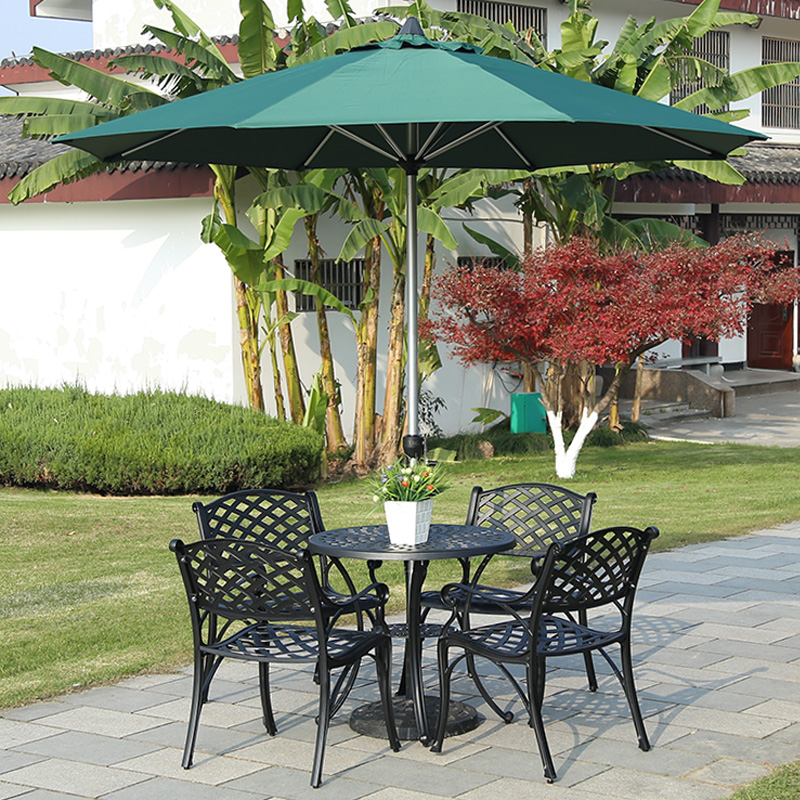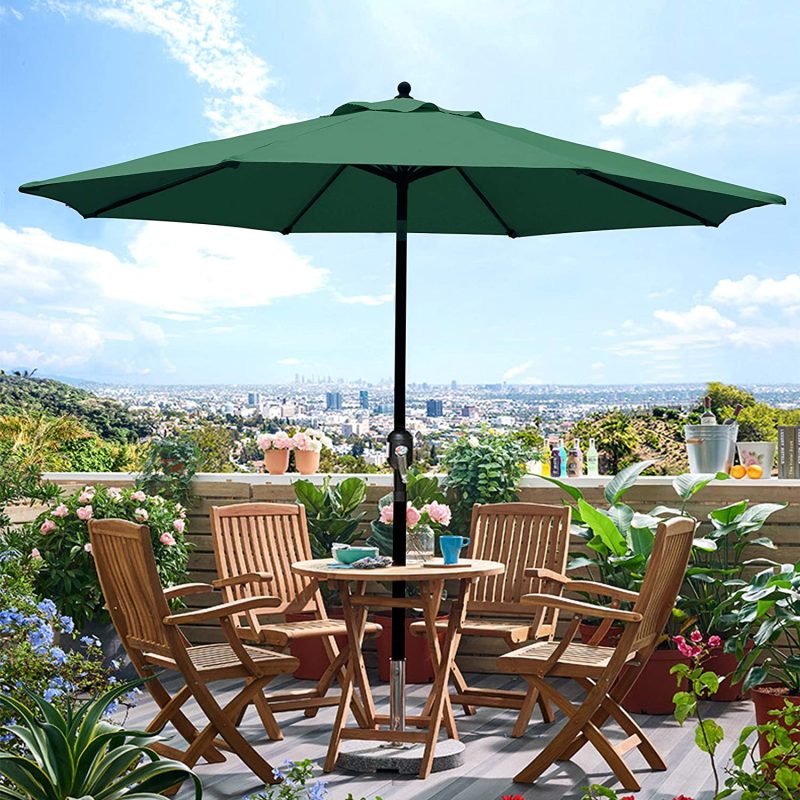Blog
10 Patio Umbrella Buying Guide

A patio umbrella provides essential protection against outdoor elements like the sun and rain. Learn more about patio
construction and styles Patio Umbrella Buying Guide

A patio umbrella is essential in enjoying your outdoor space. By providing overhead protection from natural elements
(including the sun, precipitation, and wind), an outdoor umbrella enables you to relax in comfort whether poolside, or in
your backyard. Determining the right shade for your outdoor space can prove daunting with the many sizes and styles
available. This guide provides everything you need to consider -from size, material, style, and features- to make an
informed decision on selecting the best patio umbrella for your space. Patio Umbrella Buying Guide
Patio Umbrella Buying Guide
A patio umbrella frame is made up of the pole, the ribs (that support the canopy), finial, and several mechanisms which
allow it to operate smoothly. These include the lift mechanism, tilt mechanism, hubs, and rotating mechanism (in the
case of offset umbrellas). To understand how the frame and mechanisms work together, we’ve included some basic
information about each of the system components: Patio Umbrella Buying Guide
Pole
Umbrella poles can be solid, or made up of two pieces. In a two piece pole, the pieces are connected together to form
the entire pole and this type of umbrella is the easiest to ship and to store. Single piece poles are stronger and more
suited to commercial uses such as restaurants, hotels, and condo pool areas because they stand up to strong winds
and wind gusts better. Patio Umbrella Buying Guide
Ribs
The umbrella canopy is supported by ribs which are mounted on the pole. There are two kinds of ribs on patio
umbrellas. The main ribs outspread from the top hub to the edges of the umbrella canopy. Main ribs are located under
the canopy fabric and support the fabric panels. The support ribs are connected to both the runner hub and the main
ribs and facilitate the opening and closing motion of the umbrella. The more ribs an umbrella has, the stronger and more
stable the umbrella is. The strongest ribs are made from fiberglass (which usually last four to five times longer than ribs
made from wood or aluminum).
Hub
There are two hubs in most patio umbrellas. The runner hub moves up and down the umbrella pole. The support ribs of
the umbrella are fastened to the runner hub and facilitate the opening and closing of the umbrella. There is a top hub to
which an umbrella’s main ribs are attached. This top hub does not move while the main ribs rise and fall as the umbrella
is opened and closed.
Finial
A patio umbrella finial performs two functions. It helps anchor the umbrella canopy to the frame of the umbrella. Finials
are also a design element which completes the finished look for the top of the umbrella.
Patio Umbrella Materials
Canopy Material
The umbrella canopy adds not only aesthetic value to your outdoor space, but is the material that directly protects you
from outdoor elements such as sun, wind, and rain. When it comes to outdoor textiles, each display their own set of
benefits:
Industry leader in outdoor fabric
Fade-proof with locked-in color that is resistant to UV-rays
Water repellent fabric finish, resistant to mold and mildew
Patio Umbrella Buying Guide: Choosing the Perfect Shade for Your Outdoor Space
Introduction (100 words): A patio umbrella is a functional and stylish addition to any outdoor space, providing shade and protection from the sun’s harsh rays. Whether you have a spacious backyard, a cozy balcony, or a bustling restaurant patio, selecting the right patio umbrella requires careful consideration. In this buying guide, we will explore the key factors to keep in mind when purchasing a patio umbrella. From size and material to tilt mechanisms and canopy fabrics, we will delve into the essential features that will help you make an informed decision and create a comfortable and inviting outdoor oasis.
Size and Shape (200 words): The first consideration when buying a patio umbrella is determining the appropriate size and shape for your outdoor space. Measure the area where you plan to place the umbrella to ensure a proper fit. The size of the umbrella will depend on the available space and the amount of shade you desire. Common sizes range from 6 feet to 11 feet in diameter, with larger umbrellas providing more extensive coverage.
Shape options include round, square, rectangular, and octagonal. Round umbrellas are versatile and classic, while square and rectangular umbrellas are well-suited for larger dining sets or rectangular patio layouts. Octagonal umbrellas offer a unique aesthetic appeal and are a popular choice for many outdoor spaces.
Material and Construction (250 words): The material and construction of a patio umbrella greatly impact its durability and performance. The frame is typically made of aluminum, wood, or fiberglass. Aluminum frames are lightweight, durable, and resistant to rust, making them a popular choice for outdoor use. Wood frames, often made of hardwoods like teak or eucalyptus, provide a natural and elegant look but require regular maintenance to prevent weathering. Fiberglass frames offer flexibility, strength, and resistance to extreme weather conditions, making them a durable option for windy areas.
Canopy fabrics are another crucial consideration. Look for materials that are UV-resistant, water-resistant, and fade-resistant to ensure long-lasting performance. Common canopy fabrics include polyester, acrylic, and olefin. Polyester is affordable, lightweight, and easy to clean, while acrylic is known for its vibrant colors and excellent UV resistance. Olefin is a synthetic fabric that is resistant to mold, fading, and staining, making it ideal for outdoor use.
Tilt Mechanism and Adjustability (150 words): A patio umbrella with a tilt mechanism provides versatility and allows you to adjust the angle of the canopy to block the sun at different times of the day. The most common tilt mechanisms are collar tilt, push-button tilt, and crank tilt. Collar tilt umbrellas require manually adjusting a collar to tilt the canopy. Push-button tilt umbrellas have a simple push-button mechanism for tilting. Crank tilt umbrellas utilize a crank handle to raise, lower, and tilt the canopy.
Consider the adjustability options of the umbrella, such as the ability to rotate 360 degrees or tilt in multiple directions. These features allow you to customize the shade coverage and adapt to changing sun positions throughout the day.
Base and Stability (150 words): A sturdy and stable base is essential for keeping your patio umbrella secure. The type of base you choose will depend on the umbrella’s size and the location where it will be placed. Options include freestanding bases, which are weighted and can be moved easily, and table-based or offset bases, which fit into a patio table or allow for more flexibility in positioning the umbrella.
Ensure that the base is made of durable materials like cast iron or steel and has sufficient weight to withstand wind gusts. Some bases can be filled with sand or water to provide additional stability. Additionally, consider using additional support options like umbrella weights or anchoring systems for extra security, especially in windy areas.
Patio Umbrella Buying Guide: Creating a Stylish and Shaded Outdoor Retreat
Introduction (100 words): A patio umbrella is a must-have accessory for anyone looking to create a comfortable and shaded outdoor space. Whether you have a sprawling backyard, a cozy balcony, or a bustling restaurant patio, choosing the right patio umbrella requires careful consideration. In this buying guide, we will explore the key factors to keep in mind when purchasing a patio umbrella. From size and material to canopy type and functionality, we will provide you with the essential information to make an informed decision and transform your outdoor area into a stylish and inviting retreat.
Size and Shape (200 words): One of the first things to consider when buying a patio umbrella is the size and shape that will best suit your needs. Measure the area where you plan to place the umbrella to ensure a proper fit. The size of the umbrella will depend on the amount of shade you desire and the available space. Common sizes range from 6 feet to 11 feet in diameter, with larger umbrellas providing more extensive coverage Patio Umbrella Buying Guide.
When it comes to shape, there are various options to choose from, including round, square, rectangular, and octagonal. Round umbrellas are versatile and classic, while square and rectangular umbrellas are well-suited for larger dining sets or rectangular patio layouts. Octagonal umbrellas offer a unique aesthetic appeal and are a popular choice for many outdoor spaces.
Material and Construction (250 words): The material and construction of a patio umbrella play a significant role in its durability and performance. The frame is typically made of materials like aluminum, wood, Patio Umbrella Buying Guide or fiberglass. Aluminum frames are lightweight, durable, and resistant to rust, making them an excellent choice for outdoor use. Wood frames, such as those made from teak or eucalyptus, provide a natural and timeless look,Patio Umbrella Buying Guide but they require regular maintenance to withstand the elements. Fiberglass frames offer flexibility, strength, and resistance to extreme weather conditions, making them ideal for areas with strong winds. Patio Umbrella Buying Guide
Another essential consideration is the canopy fabric. Look for materials that are UV-resistant, water-resistant, and fade-resistant to ensure long-lasting performance. Common canopy fabrics include polyester, Patio Umbrella Buying Guide acrylic, and olefin. Polyester is an affordable option that is lightweight and easy to clean. Acrylic fabrics are known for their vibrant colors and excellent UV resistance. Olefin, a synthetic fabric, is highly resistant to mold, fading, and staining, Patio Umbrella Buying Guide making it a popular choice for outdoor use. Patio Umbrella Buying Guide
Functionality and Features (200 words): Consider the functionality and features that will enhance your outdoor experience. Tilt mechanisms allow you to adjust the angle of the canopy to block the sun at different times of the day. Patio Umbrella Buying Guide Common tilt options include collar tilt, push-button tilt, and crank tilt. Collar tilt umbrellas require manually adjusting a collar to tilt the canopy. Push-button tilt umbrellas have a simple push-button mechanism, while crank tilt umbrellas utilize a crank handle to raise, lower, and tilt the canopy. Patio Umbrella Buying Guide
Other features to look for include a vented canopy that allows air to flow through, reducing wind resistance and enhancing stability. Some umbrellas also come with a pulley system for easy opening and closing, as well as a storage cover for protection when not in use. Additionally, consider the overall functionality and ease of use, including the height adjustability and the ability to rotate the umbrella 360 degrees.
Base and Stability (150 words): A sturdy and stable base is essential for keeping your patio umbrella secure. The type of base you choose will depend on the umbrella’s size and the location where it will be placed. Options include freestanding bases, which are weighted and can be moved easily, and table-based or offset bases, which fit into a patio table or provide more flexibility in positioning the umbrella. Patio Umbrella Buying Guide
Ensure that the base is When buying a patio umbrella, several key factors need to be considered. First, determining the appropriate size and shape is crucial, as it should fit the available space and provide adequate shade. Sizes typically range from 6 to 11 feet in diameter, while shape options include round, square, rectangular, and octagonal. The material and construction of the umbrella are also essential for durability and performance. Aluminum frames are lightweight and rust-resistant, wood frames offer a natural look but require maintenance, and fiberglass frames are strong and suitable for windy areas. Canopy fabrics should be UV-resistant, water-resistant, and fade-resistant, with options like polyester, acrylic, and olefin. Functionality features, such as tilt mechanisms for adjusting the angle of the canopy, vented canopies for airflow, and additional conveniences like pulley systems and storage covers, enhance the overall experience. Lastly, choosing a sturdy and stable base is crucial, with options including freestanding, table-based, or offset bases depending on the umbrella’s size and placement. By considering these factors, you can select the perfect patio umbrella and create a stylish and shaded outdoor retreat.Patio Umbrella Buying Guide
Patio Umbrella Guide: Creating the Perfect Outdoor Oasis Patio Umbrella Buying Guide
Introduction (100 words): A patio umbrella is an essential component of any outdoor space, providing shade and style to create a comfortable and inviting atmosphere. Whether you have a spacious backyard, a cozy patio, or a bustling restaurant terrace, choosing the right patio umbrella requires careful consideration. In this comprehensive guide, we will explore the key factors to consider when purchasing a patio umbrella. From size and material to canopy type and functionality, we will provide you with the necessary knowledge to make an informed decision and transform your outdoor area into a stunning oasis.
Size and Shape (200 words): One of the first considerations when selecting a patio umbrella is its size and shape. The size of the umbrella depends on the amount of shade you desire and the available space. Measure the area where you plan to place the umbrella to ensure a proper fit. Common sizes range from 6 to 11 feet in diameter, with larger umbrellas providing more extensive coverage.
The shape of the umbrella is another important aspect to consider. Round umbrellas are versatile and classic, suiting various outdoor settings. Square and rectangular umbrellas are ideal for larger dining sets or rectangular patio layouts, maximizing the use of space. Octagonal umbrellas offer a unique aesthetic appeal and are popular choices for many outdoor areas.
Material and Construction (250 words): The material and construction of a patio umbrella play a significant role in its durability and longevity. The frame is typically made of materials such as aluminum, wood, or fiberglass.
Aluminum frames are popular due to their lightweight nature, durability, and resistance to rust. They are an excellent choice for outdoor use as they can withstand various weather conditions. Wood frames, such as teak or eucalyptus, provide a natural and timeless look that adds warmth to any outdoor space. However, they require regular maintenance to protect them from moisture and sunlight. Fiberglass frames offer flexibility, strength, and resistance to extreme weather conditions, making them ideal for areas with high winds.
The canopy fabric is another critical aspect to consider. Look for materials that are UV-resistant, water-resistant, and fade-resistant to ensure longevity. Polyester is a commonly used fabric that is lightweight, affordable, and easy to clean. Acrylic fabrics are known for their vibrant colors, excellent UV resistance, and high durability. Olefin, a synthetic fabric, is highly resistant to mold, fading, and staining, making it a popular choice for outdoor use.
Functionality and Features (200 words): Consider the functionality and features that will enhance your outdoor experience with the patio umbrella. Tilt mechanisms allow you to adjust the angle of the canopy to block the sun at different times of the day.
Common tilt options include collar tilt, push-button tilt, and crank tilt. Collar tilt umbrellas require manually adjusting a collar to tilt the canopy, offering precise control. Push-button tilt
umbrellas have a simple push-button mechanism, making adjustments quick and effortless. Crank tilt umbrellas utilize a crank handle to raise, lower, and tilt the canopy, providing ease of use.
Vented canopies are another useful feature to consider. They allow air to flow through the umbrella, reducing wind resistance and enhancing stability during gusty conditions. Some umbrellas also come with a pulley system for easy opening and closing, eliminating the need for excessive force. Additionally, storage covers are available to protect the umbrella when not in use, prolonging its lifespan.
Base and Stability (150 words): Selecting a sturdy and stable base is essential for keeping your patio umbrella secure. The type of base you choose depends on the umbrella’s size and the location where it will be placed. Freestanding bases are weighted and can be easily moved, providing flexibility in positioning the umbrella. Table-based or offset bases fit into a patio table or are
